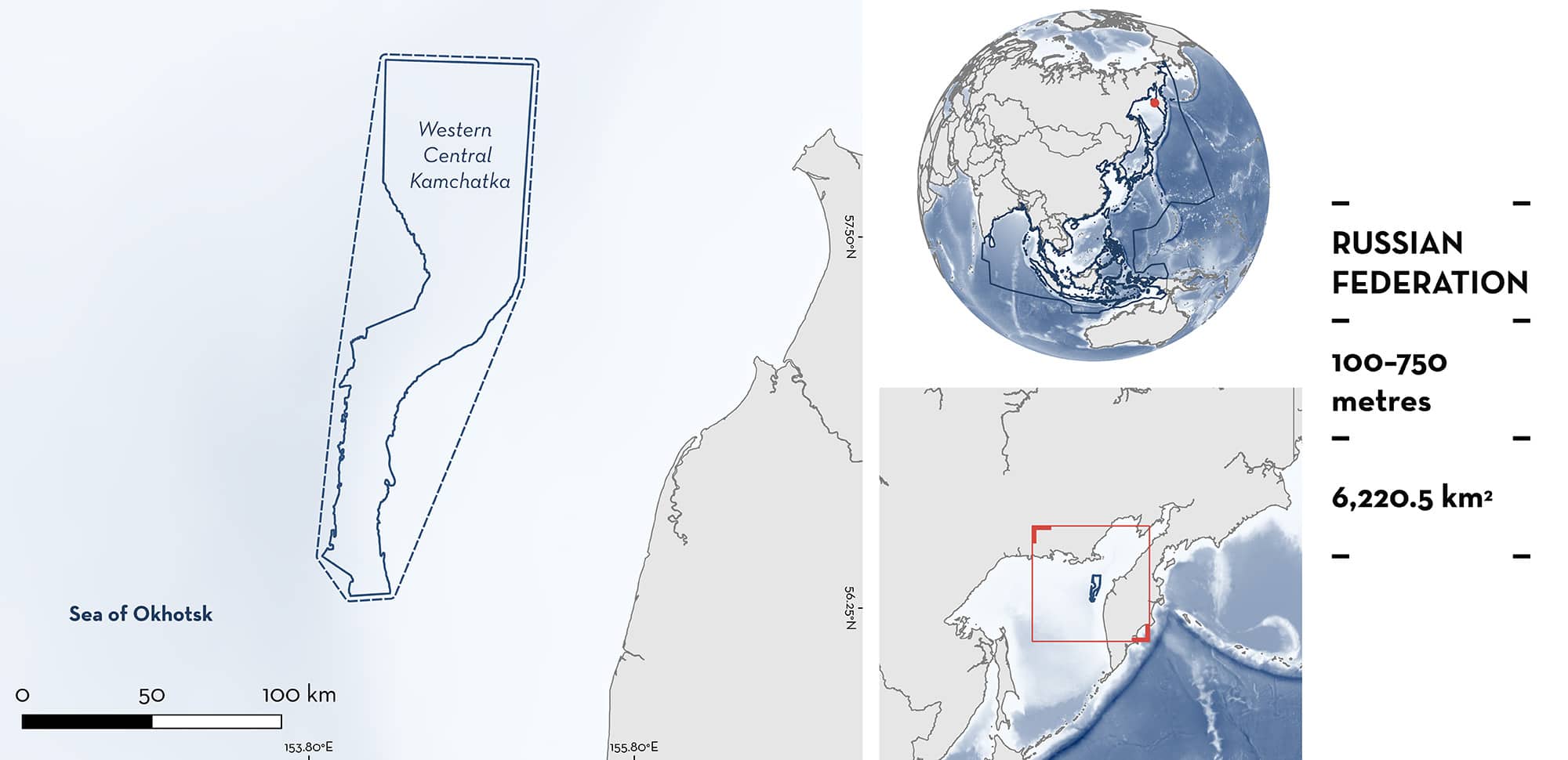ISRA FACTSHEETS
ISRA FACTSHEETS
ASIA REGION
Western Central Kamchatka
Summary
Western Central Kamchatka is located in the Sea of Okhotsk, in waters of the Russian Federation. The area is characterised by a gentle and flat slope. It overlaps with the West Kamchatka Shelf Ecologically or Biologically Significant Marine Area. Within the area there are: undefined aggregations (e.g., Raspback Skate Bathyraja isotrachys).
Download factsheet
Western Central Kamchatka
DESCRIPTION OF HABITAT
Western Central Kamchatka is located in the Sea of Okhotsk, in the Far Eastern Federal District of the Russian Federation. It represents part of the seventh standard area for averaging biostatistical information during ongoing monitoring studies in the Northwest Pacific Ocean (Shuntov et al. 2014). This is one of the most biologically productive areas of the world (CBD 2024). It is characterised by a gentle and flat slope.
The oceanography of the area is highly influenced by strong cyclonic currents, including the warm West Kamchatka current and the cold Yamskoe and East Sakhalin currents, with an eddie in between (CBD 2024).
The area overlaps with the West Kamchatka Shelf Ecologically or Biologically Significant Marine Area (CBD 2024).
This Important Shark and Ray Area is benthopelagic and subsurface and is delineated from 100 m to 750 m based on the depth range of the Qualifying Species in the area.
CRITERION C
SUB-CRITERION C5 – UNDEFINED AGGREGATIONS
Western Central Kamchatka is an important area for undefined aggregations of two ray species.
Skates are known to aggregate with temporal changes related to sex and life-stage segregations (Swain & Benoît 2006; Frisk 2010; Hoff 2016). Skates usually aggregate in high density areas where large catch quantities for these species occur (Bizzarro et al. 2014). Here, catch-per-unit-effort (CPUE, individuals/km2) can be used as an indicator of aggregations for skate species (Orlov & Volvenko 2022). Scientific surveys using benthic trawls between 2010–2021 showed that aggregations of Raspback Skate and Whiteblotched Skate regularly occur in Western Central Kamchatka (Orlov & Volvenko 2022; Kurbanov & Vinogradskaya 2023; Orlov & Volvenko unpubl. data 2023). CPUE for each species was calculated based on the area swept by survey trawls (Volvenko 2014; Orlov & Volvenko 2022).
This area holds the largest abundance of Raspback Skate (mean: 189 individuals/km2, max: 423 individuals/km2) in Russian waters of the Northwest Pacific (Orlov & Volvenko 2022). Individuals of this species were caught in other areas of the region but in minimal numbers compared to Western Central Kamchatka. The largest abundances were found between December–May at depths of 250–750 m, with multiple individuals caught in a single haul (Orlov & Volvenko 2022). More information is needed to confirm the nature and function of these aggregations.
This area holds the second largest abundance of Whiteblotched Skate (mean: 102 individuals/km2, max: 982 individuals/km2) in Russian waters of the Northwest Pacific and it was absent from near areas in the southwestern coast of Kamchatka (Orlov & Volvenko 2022; Kurbanov & Vinogradskaya 2023; Orlov & Volvenko unpubl. data 2023). Individuals of this species were caught in other areas of the region but in minimal numbers compared to Western Central Kamchatka. Individuals were found year-round at depths of 100–863 m, with higher abundances found at 400–700 m and temperatures between 0–3°C. Multiple individuals were caught in multiple hauls. More information is needed to confirm the nature and function of these aggregations.
Download factsheet
SUBMIT A REQUEST
ISRA SPATIAL LAYER REQUEST
To make a request to download the ISRA Layer in either a GIS compatible Shapefile (.shp) or Google Earth compatible Keyhole Markup Language Zipped file (.kmz) please complete the following form. We will review your request and send the download details to you. We will endeavor to send you the requested files as soon as we can. However, please note that this is not an automated process, and before requests are responded to, they undergo internal review and authorization. As such, requests normally take 5–10 working days to process.
Should you have questions about the data or process, please do not hesitate to contact us.


